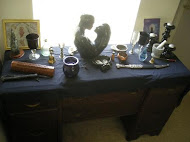Children's Book of Shadows
By Baboo Kyra Finch (permission given – you can find more work from this wonderful lady at A Witch’s Teat)
A Book of Shadows can be a Pagan equivalent of a Baby Book. It's a record of your children's growth and development into strong, creative, and psychic individuals. Keep a copy for yourself for as long as they will allow you to do so. I recently found some stories and drawings by my older daughter from her
grammar school days. One is a picture of Morgana Le Fay, her namesake. The story is about a magick necklace lost by a Witch and found by a young girl. Her birthright is clearly shining through the pages. I prefer using a loose leaf notebook with page holes reinforced. This way you can keep sections organized
according to topic. If this is too anal for you, do whatever works.
Have your child decorate the binder. It will create a sense of ownership from the very beginning. Book should contain stories, crafts, pressed plants, spells, drawings, chants, and so on. Just remember whose Book it is. You can make your own! Include your kid's favorite folk stories and faerie tales and their
illustrations. I have some wonderful drawings of Baba Yaga's dancing house done by my camp kids. Put in all the stories they create, preferably dictated and transcribed in their own words. Read these together, often, from the Book, adding to them, making changes. Keep the originals intact. I like to leave several blank pages between each entry for this purpose. Date everything. The beauty of this is in watching the changes take place.
Learning how to create poetry is especially important. Poetry turns into spells and chants. Rhyming words have a great deal of power. A person who can think in rhyme can harness their Will efficiently. Start with simple rhyming words. Progress to couplets and limericks. Use a drum to teach rhythm. Put everything
into the book. Date the pictures from all the Sabbats. Take pictures of all altars. Have your child describe ritual robes, items on the altars, and the purpose of the ritual as they see it. Write it down. date it! As you have probably guessed, I am very bad at dating things. Learn from my mistakes. It's hard to brag about what an amazing Witchlet your child is if you can't remember whether he drew the picture when he was three or nine years old. Oh, if you can't remember, say three. It sounds better.
Keep a separate section on herb lore and healing. You can get plastic covers to protect pages of glued on, pressed plants. Otherwise, you're likely to find a fine powder and some fat silverfish instead of a plant sample in a few years. It's a good idea to have only one or two plants on each page. Date it. Note the names (Latin and common) of the plant, where it was found, what it is used for and any myths or folk lore attached to the plant. On the back of the page, you can write down recipes, cautions, and the results of personal use. Does it taste good? Does it sting? Did it work? What's the best way to use it: tea, tincture, salve, or poultice?
You should be merely a secretary. All information should be in your child's own words. It's also interesting to have samples of the same plant taken at different times of the year. Note when it flowers, fruits, and goes dormant. Plants can look remarkably different from location to location, and in different seasons. It's a good idea to learn to identify plants from one or two consistent characteristics. Write these down and keep track of the usefulness of the information. For example: poison hemlock smells like a dirty mouse den – wild celery smells like celery, wild carrot (Queen Anne's Lace) smells like carrots; comfrey smells like cucumbers - Foxglove does not; Nettles' leaves look like they were cut with pinking shears and they sting. Plantain has veins that come from the center of the stem, rather than branching from a central vein; it has concave stems and grows from a central cluster. Learning to look at plants gives a real sense of how the wheel of the year turns, the Goddess Changes, and the Green Man is born, grows old, seeds and dies and is once again born in the spring.
You can make similar entries for feathers, noting the bird it came from, when you found it, and what it represents. Owl feathers are striped and denote wisdom. Raven feathers are longer and more blade shaped than Crow feathers. The Red Breasted Flicker has bright orange feathers. Find special rocks. Try to identify them and enter the information along with the date and circumstances under which you found them. Ask about the deities and the Sabbats and transcribe what your child tells you. Take pictures of your child dressed as Gods and Goddesses.
This is a good place to start teaching your child the runes and other secret alphabets. I've found that children who start learning to read and write before four absorb the ability as a language rather than a skill. They stash it in a different part of the brain, a deeper part, and never remember not knowing how to do these things. I think that children with several languages, including American Sign Language and the scribing languages, perceive the world in a broader and more varied manner. They don't just think in terms of sound, but with their eyes and bodies as well. When you have added the non-spoken languages to their repertoire, you have people who think and communicate in many different dimensions. This increases psychic abilities.
This book is a journal, not of the mundane world but the world of Spirit. Treasure the pages you've copied. You can share it until the day the book's owner tells you that it is private. At that time, go in your bathroom and have a good cry. Your baby just took another snip out of the umbilical cord. My grandfather read to me daily. My mother and grandmother told me stories, took me to the ballet and other forms of theater. This is how I learned about the deities, and how I taught my children.
For more ideas on creating a book of shadows, you can go here, here, and here.
bb,
Disclaimer: No one involved in this blog or its contents may be held responsible for any adverse reactions arising from following any of the instructions/recipes on this list. It is the reader's personal responsibility to exercise all precautions and use his or her own discretion if following any instructions or advice from `this blog.
















No comments:
Post a Comment